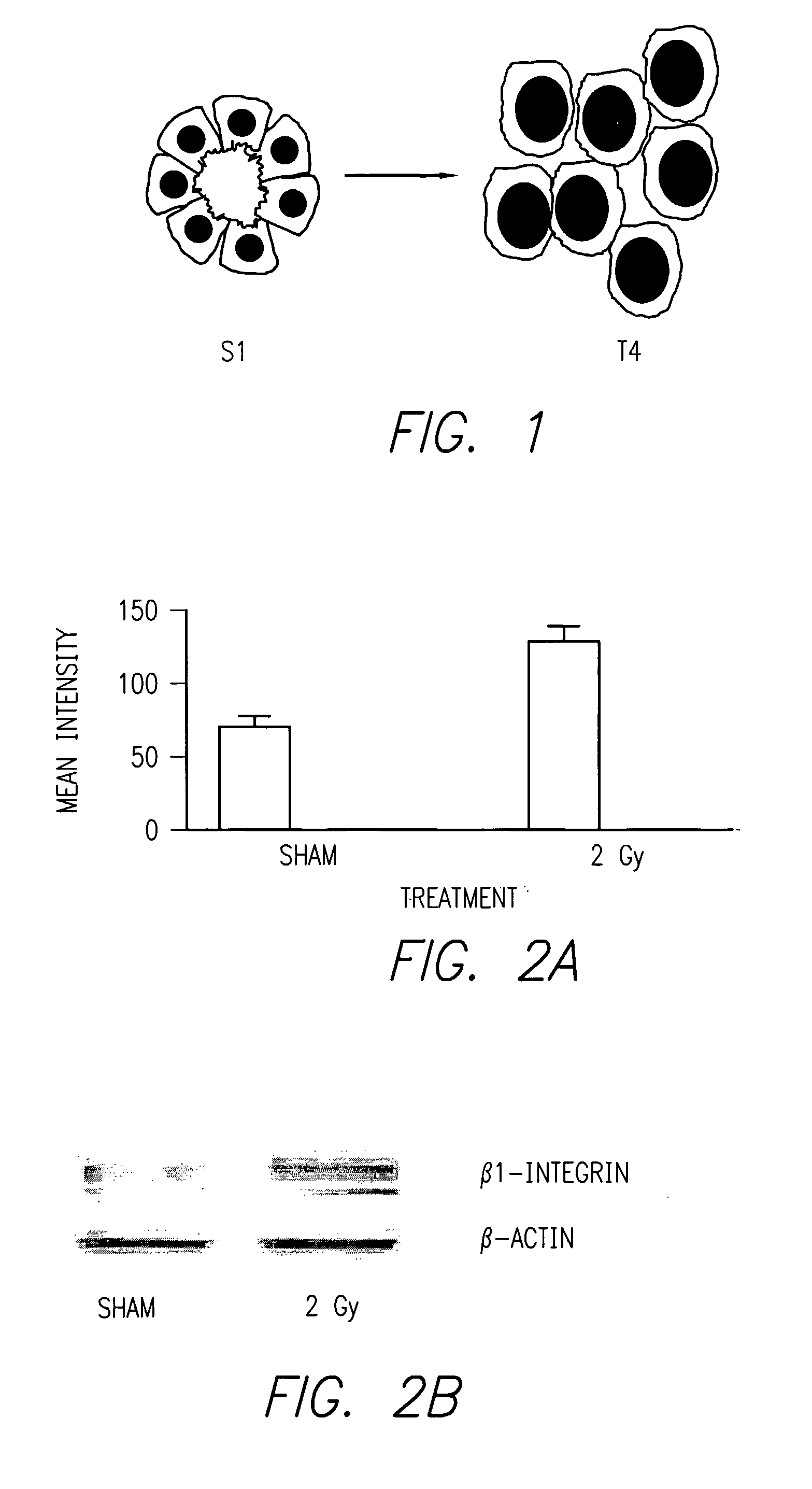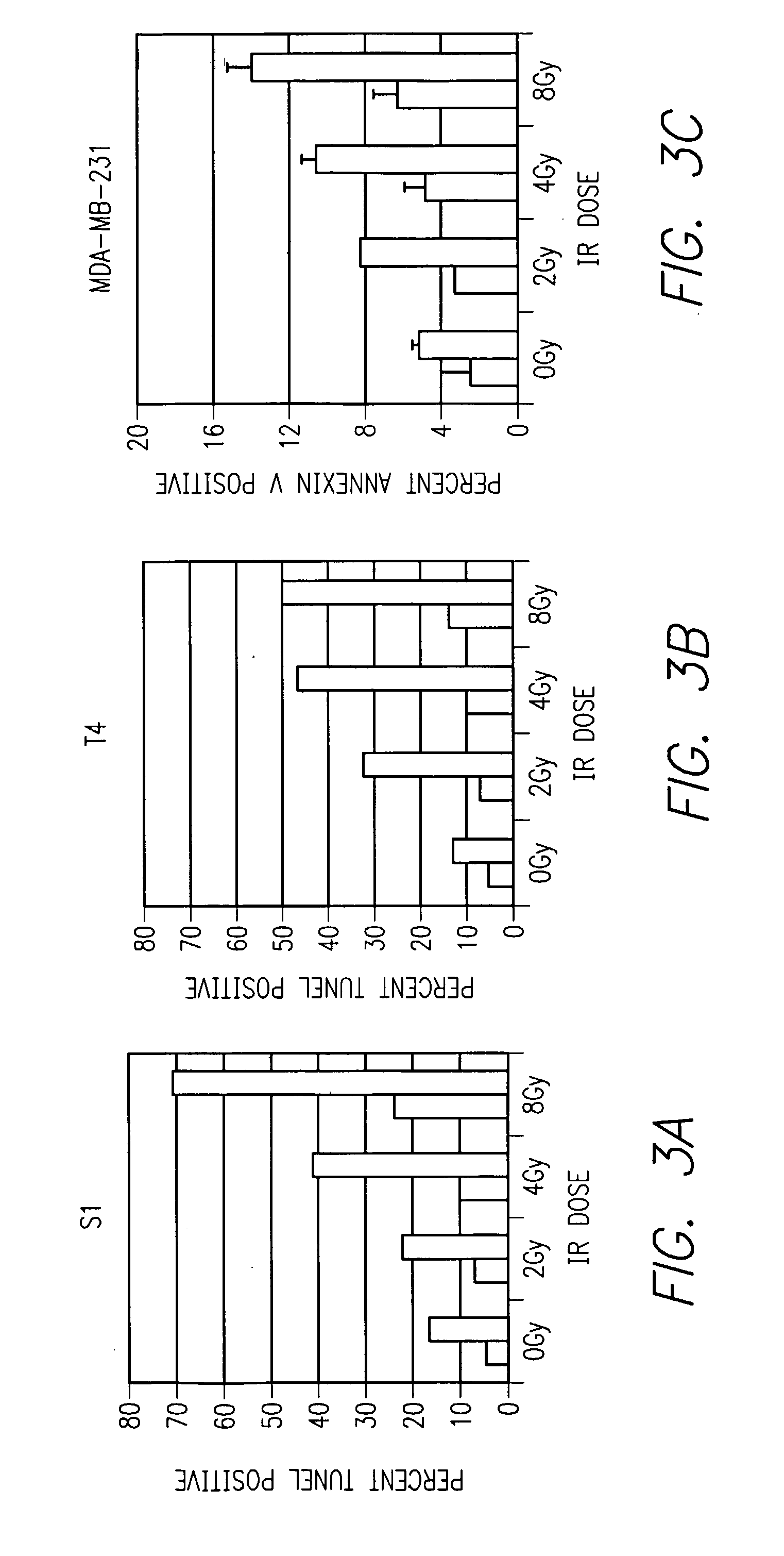Method of Increasing Radiation Sensitivity by Inhibition of Beta One Integrin
- Summary
- Abstract
- Description
- Claims
- Application Information
AI Technical Summary
Benefits of technology
Problems solved by technology
Method used
Image
Examples
example 1 (fig.2)
Example 1 (FIG. 2)
β1 integrin expression is persistently increased in progeny of human mammary epithelial cells after single doses of ionizing radiation.
[0058] Referring now to FIG. 2, it can be seen that the progeny of human mammary epithelial cells (S1) exposed to single doses of ionizing radiation (2 Gy) in 3-D culture upregulate expression of β1 integrin, shown in FIG. 2 (bottom) by immunohistochemistry and in protein immunoblot analysis [Reference 15]. FIG. 2B shows blots wherein the treated cells show an approximately two fold increase in mean intensity. The bar graph at the top panel of FIG. 2 shows nearly a two fold intensity of staining for beta-1 integrin after 2 Gy radiation treatment of the S1 cells.
[0059] This phenotype was shown to persist for multiple generations of daughter cells among surviving colonies. These findings are consistent with other reports of IR-induced integrin expression [Reference 16, 34, 35], and implicate cell-ECM interactions as a mechanism of I...
example 2 (fig.3)
Example 2 (FIG. 3)
β1 integrin inhibition results in enhanced dose-dependent IR induced apoptosis in 2-D culture
[0060] Initial studies began by testing the effect of AIIB2, a β1 integrin inhibitory antibody, with escalating doses of IR in human mammary epithelial cells plated on standard tissue culture plastic. Mammary epithelial cell lines, S1 (non-malignant) and T4 and MDA-MB-231 (malignant) were used. Cells were plated on Day 0, and 0.08 mg / ml AIIB2 was added at Day 2, media was washed prior to IR exposure delivered at ˜2 Gy / minute using a Cesium source on Day 3. Cells were assayed for apoptosis on Day 4 using fluorescence-activated cell sorting (FACS) analysis for TUNEL and Annexin V immunoreactivity. For all cell lines, AIIB2 alone resulted in increased apoptosis, and the combination of AIIB2 and IR resulted in an IR dose-dependent increase in apoptosis (FIG. 3).
[0061] Referring now to FIG. 3, the three bar graphs show apoptosis (TUNEL assay) after different IR doses in malign...
example 3 (fig.4)
Example 3 (FIG. 4)
Expression of β1 Integrin in a variety of cell lines
[0064] Both T4 and MDA-MB-231 cell lines overexpress β1 integrin compared to S1, non-tumorigenic cells. To address whether or not β1 integrin expression predicted the response to AIIB2 treatment, also tested were several other breast cancer cell lines for β1 integrin expression, as shown in FIG. 4. Six cell lines (S1, T4, MDA-MB-231, SKBR3, BT474 and MCF-7) were assayed for total β1 integrin expression using Western immunoblot, and demonstrated different levels of expression. These cell lines were tested for response to AIIB2, at both low and high doses of antibody as indicated below. Controls included on-specific rat IgG (Pierce) indicating that response to AIIB2 was specific. All malignant cell lines, regardless of β1 integrin expression level, responded similarly to AIIB2 with increased apoptosis and decreased proliferation (FIG. 4). Therefore, in this in vitro model, β1 integrin expression level did not pred...
PUM
| Property | Measurement | Unit |
|---|---|---|
| Time | aaaaa | aaaaa |
| Air kerma rate | aaaaa | aaaaa |
| Solar gamma radiation | aaaaa | aaaaa |
Abstract
Description
Claims
Application Information
 Login to View More
Login to View More - R&D
- Intellectual Property
- Life Sciences
- Materials
- Tech Scout
- Unparalleled Data Quality
- Higher Quality Content
- 60% Fewer Hallucinations
Browse by: Latest US Patents, China's latest patents, Technical Efficacy Thesaurus, Application Domain, Technology Topic, Popular Technical Reports.
© 2025 PatSnap. All rights reserved.Legal|Privacy policy|Modern Slavery Act Transparency Statement|Sitemap|About US| Contact US: help@patsnap.com



